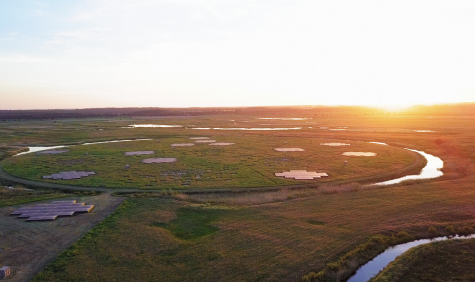New technology for lightning-fast data traffic: SURF and ASTRON realise 400G connection with OpenZR+
Since July 2024, SURF members requiring a network upgrade for their research can request additional bandwidth or supplementary services within the All-In network rate. Using this approach, we established a direct connection for ASTRON between its research facilities in Groningen and Dwingeloo, increasing bandwidth from 10 to 400 Gigabits per second.
Faster data transmission LOFAR telescope
For astronomers working with the LOFAR telescope, this network upgrade enables an even more detailed study of the universe. LOFAR (Low Frequency Array) is the world's largest radio telescope operating at the lowest frequencies observable from Earth. The telescope consists of thousands of small antennas spread across Europe.
Thanks to the improved network connection, LOFAR can now transmit more signals simultaneously to a central computer (the ‘correlator’), which processes the data and converts it into images of space. The increased bandwidth not only speeds up this process but also enhances the quality, resulting in even sharper LOFAR images.
Collaboration strengthens research
Additionally, astronomers can use the new network connection to subscribe to multicast streams of data directly from the LOFAR stations. “This provides researchers with direct, real-time access to the most recent scientific data exactly when they need it,” says Julian Kootstra, network engineer at ASTRON. “If you have your own cluster, you gain instant access to new data – a revolutionary way to push the boundaries of our knowledge.”
Paul Klop, optical network architect at SURF, is also pleased with the results: “With this 400G connection, we support ASTRON researchers in achieving their scientific goals. The collaboration with ASTRON went exceptionally well and demonstrates how we can work together with our members to deploy innovative technologies that enable groundbreaking research.”
Benefits OpenZR+ technology
The network upgrade at ASTRON was implemented using 400G-ZR optics, a technology that amplifies signals within the network without requiring separate transponders. This reduces the need for intermediary components, simplifying network complexity. This provides several benefits:
- Lower risk of failures
- Simplified network management
- Reduced costs through more efficient equipment
- Lower power consumption, contributing to sustainable data processing
- More compact equipment, allowing for more efficient data centre layouts
In SURF’s future network, SURFnet-Infinity, OpenZR+ technology will become the standard for all medium-distance connections.
SURFnet-Infinity: the future of research networks
The 400G upgrade aligns with our broader strategy to develop the network of the future: SURFnet-Infinity. This network, based on open standards, enables equipment from different vendors to connect seamlessly over long distances. As a result, the SURF network becomes more flexible and future-proof.
Through the All-In network tariff, we aim to provide education and research institutions with network solutions tailored to their specific needs, enabling us to better support the Dutch research community.
More information and contact
For press inquiries, please contact:
Tom Hoven, SURF
tom.hoven@surf.nl
+31 6 414 39 398
Josine Haas, ASTRON
haas@astron.nl
+31 6 209 88 561
